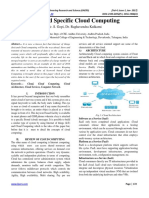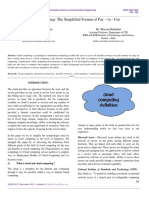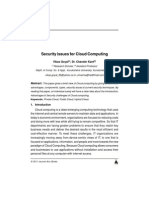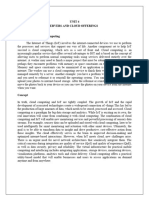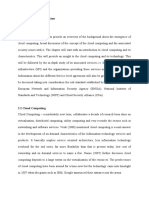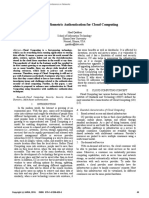0 ratings0% found this document useful (0 votes)
22 viewsSynposis Virtualization
Synposis Virtualization
Uploaded by
harshit96023This document provides an overview of virtualization in cloud computing. It discusses that virtualization allows a single machine to run multiple operating systems and applications concurrently in isolated virtual environments. This improves hardware utilization and reduces costs. Virtualization is a key component of cloud computing, enabling data sharing, computing and storage services. The document describes different types of virtualizations used in cloud computing including network virtualization and storage virtualization. Network virtualization creates multiple virtual networks from a single physical network, while storage virtualization manages multiple physical storage arrays as a single storage device.
Copyright:
© All Rights Reserved
Available Formats
Download as PDF, TXT or read online from Scribd
Synposis Virtualization
Synposis Virtualization
Uploaded by
harshit960230 ratings0% found this document useful (0 votes)
22 views6 pagesThis document provides an overview of virtualization in cloud computing. It discusses that virtualization allows a single machine to run multiple operating systems and applications concurrently in isolated virtual environments. This improves hardware utilization and reduces costs. Virtualization is a key component of cloud computing, enabling data sharing, computing and storage services. The document describes different types of virtualizations used in cloud computing including network virtualization and storage virtualization. Network virtualization creates multiple virtual networks from a single physical network, while storage virtualization manages multiple physical storage arrays as a single storage device.
Original Description:
resume
Original Title
synposis virtualization
Copyright
© © All Rights Reserved
Available Formats
PDF, TXT or read online from Scribd
Share this document
Did you find this document useful?
Is this content inappropriate?
This document provides an overview of virtualization in cloud computing. It discusses that virtualization allows a single machine to run multiple operating systems and applications concurrently in isolated virtual environments. This improves hardware utilization and reduces costs. Virtualization is a key component of cloud computing, enabling data sharing, computing and storage services. The document describes different types of virtualizations used in cloud computing including network virtualization and storage virtualization. Network virtualization creates multiple virtual networks from a single physical network, while storage virtualization manages multiple physical storage arrays as a single storage device.
Copyright:
© All Rights Reserved
Available Formats
Download as PDF, TXT or read online from Scribd
Download as pdf or txt
0 ratings0% found this document useful (0 votes)
22 views6 pagesSynposis Virtualization
Synposis Virtualization
Uploaded by
harshit96023This document provides an overview of virtualization in cloud computing. It discusses that virtualization allows a single machine to run multiple operating systems and applications concurrently in isolated virtual environments. This improves hardware utilization and reduces costs. Virtualization is a key component of cloud computing, enabling data sharing, computing and storage services. The document describes different types of virtualizations used in cloud computing including network virtualization and storage virtualization. Network virtualization creates multiple virtual networks from a single physical network, while storage virtualization manages multiple physical storage arrays as a single storage device.
Copyright:
© All Rights Reserved
Available Formats
Download as PDF, TXT or read online from Scribd
Download as pdf or txt
You are on page 1of 6
e-ISSN: 2582-5208
International Research Journal of Modernization in Engineering Technology and Science
( Peer-Reviewed, Open Access, Fully Refereed International Journal )
Volume:03/Issue:07/July-2021 Impact Factor- 5.354 www.irjmets.com
OVERVIEW OF VIRTUALIZATION IN CLOUD COMPUTING
Thanushree Gowda*1, Vanishree S*2, Varshitha M S*3, Yashaswini K*4,
Nethravathi B*5
*1,2,3,4Student Department Of Information Science And Engineering, JSS Academy Of Technical
Education, Bangalore, Karnataka, India.
*5Asst.Professor, Department Of Information Science And Engineering, JSS Academy Of Technical
Education, Bangalore, Karnataka, India.
ABSTRACT
Cloud computing is a useful technology and it has been emerging fastly by delivering different types of services
via internet. It includes several tools and application like data storage, database, software and network service.
In the Cloud users get an opportunity to store and retrieve their files from any web enabled services. With the
help of cloud computing the IT cost can be lowered. The users can share the data and they can access the
services according to their requirement. Cloud Computing is the preferred solution for companies extending
the infrastructure or invocations. Virtualization and virtual environment are the main key components for data
sharing, computing and storage services in cloud computing. Virtualization is in the IT industry from past many
years and it's super relevant to building the cloud services. With this technology it is possible to run multiple
operating systems andapplications which is completely isolated from each other. It is commonly used in storage
area network which allows to share the resources among multiple customers or organization at a time. This
paper has a detailed review on virtualization technology and its role in cloud computing is been explained.
Keywords: Cloud Computing, Virtualization, Network Virtualization, Iaas, Paas, Saas.
I. INTRODUCTION
Cloud computing is a system which provides on-demand services via internet connected off-site data centers. It
is a prominent technology which is widely used all over the world. Cloud computing is named as such because
users can use a remote application which are present outside the working site through internet connection
devices. There are several advantages in cloud computing such as democratizes access to easier maintenance,
reduced IT costs, versatility, reliability, security, and scalability.
Figure 1: Cloud Computing Services.
The cloud application is controlled by the user while the infrastructure is controlled by the cloud provider.
Cloud computing has three-tier services, such as Software as a Services (SaaS), Platform as a Service (PaaS) and
Infrastructure as a Service (IaaS). In SaaS, Applications are offered by the cloud provider to the user through a
pay-as-you-go model or on-demand. Before using the services,there is no need for the user to buy the license or
to install the application. This model includes platforms like Microsoft office 365, Google document and
Dropbox. In PaaS, the third-party provider supplies the hardware and the software application platforms. PaaS
vendors provides development tools, middleware, operating system, database management system and
infrastructure. This model includes platforms like Heroku, SAP cloud and Aneka. In IaaS, the public cloud
providers deliver everything from operating systems to servers on a pay-per-use basis. This model includes
platforms like Amazon Web Services (AWS) and Microsoft Azure.
www.irjmets.com @International Research Journal of Modernization in Engineering, Technology and Science
[1841]
e-ISSN: 2582-5208
International Research Journal of Modernization in Engineering Technology and Science
( Peer-Reviewed, Open Access, Fully Refereed International Journal )
Volume:03/Issue:07/July-2021 Impact Factor- 5.354 www.irjmets.com
Cloud Deployment model has four types namely Public cloud, Private cloud, Community cloud and Hybrid cloud.
The Public cloud provides both services and infrastructure which are shared by all customers and it is less
secure. The Private cloud infrastructure is used by a single organization. It is also called as corporate model or
internal model. The server can be hosted on the premises of the owner company or it can be doneexternally and
it is considered as more secure. Community cloud is the hybrid form of the private cloud. Community cloud
enables services and systems which are shared by several organizations with shared common interest. It is
managed by a third-party or an organization. The composition of public cloud and private cloud is called hybrid
cloud. Cloud computing has five vital characteristics, they are On-demand self-service, Broad network access,
Resource pooling, Rapid elasticity and Measured service.
Figure 2: Types of Cloud Computing
Virtualization plays a major role in cloud computing. Virtualization allows single machine to run multiple
platforms simultaneously. so, virtualization enables us to use same computer to work on various environment.
In virtualization all virtual environments is arranged to ensure its own security and integrity. Virtual Machine is
the one which enables to run multiple platforms in the single machine concurrently. Virtual machine is created
using both hardware and software engineering. Cloud computing system is bringing a tremendous fundamental
change in Information Technology. Virtualization improves capacity and lowers the cost of IT infrastructure in
cloud computing.
Virtualization technology provides an abstract environment about the underlying resources and simplifies their
use, supports replication and separates users from one another, which increases elasticity of the system. The
cloud often includes virtualization software which manipulates the hardware as a part of their service package.
With the help of virtualization multiple operating system and applications can run at a single time on the same
machine and a same hardware,by this we can increase the flexibility of the hardware.
II. ROLE OF VIRTUALIZATION
Virtualization plays significant role in cloud computing, which helps to use one system separately by multiple
users. This technique is done by giving a logical name to all the physical resources and based on demand it
provides a pointer to those physical resources. To share data and information virtualization technique is very
important in cloud. From underlying hardware virtual machine is logically separated. A machine called host by
which the virtual machine is created and this virtual machine is known as guest machine. The hypervisor is a
firmware which user a combination of different types hardware virtualization. The main objective of
virtualization isimprovement in security, energy saving, flexibility andreduction in cost.
III. HISTORY OF VIRTUALIZATION
Concept of virtualization was first introduced in late 1950s. Since there were no personal computers at that
time virtualization did not become successful until 1990s. IT companies realized that they could save money
and time by moving from physical to virtual environment. In 1964 IBM began to explore virtualization on
mainframes, it released an operating system called VM running on mainframes 1972. In the development of
robust time-sharing solution system IBM had invested a lot of effort and in 1999 VMware is launched.
In 2004 Intel engineers began adding hardware virtualization support to Xen to prepare the necessary software
www.irjmets.com @International Research Journal of Modernization in Engineering, Technology and Science
[1842]
e-ISSN: 2582-5208
International Research Journal of Modernization in Engineering Technology and Science
( Peer-Reviewed, Open Access, Fully Refereed International Journal )
Volume:03/Issue:07/July-2021 Impact Factor- 5.354 www.irjmets.com
for the upcoming new processor. Under their efforts Xen 3.0 was released in 2005, which began to officially
support Intel’s VT technology. Between 2006 and 2010 major traditional IT vendors introduced their own
products in terms of virtualization. In 2007 HP introduced HP-UX Integrity virtual machines and Microsoft
joined Hyper-v in Windows Server in 2008. Since then, virtualization has become very successful in today’s IT
world.
IV. TYPES OF VIRTUALIZATIONS IN CLOUD COMPUTING
Figure 3: Types of Virtualization
1. Network Virtualization:
Network virtualization helps user to create multiple individual networks from one physical area network (LAN).
In this type of virtualization, all physical networking tools and other resources are combined into a single
software-based resource. Network virtualization improves overall network’s productivity and efficiency,
flexibility, reliability, security and scalability. Few examples of network virtualization are JunosV App Engine,
Cisco Nexus and 6WIND Virtual Accelerator.
2. Storage Virtualization:
A virtual storage system manages multiple physical storage arrays which appears to be a single storage device.
The resources needed can be increased by the centralized virtual storage system by increasing availability and
flexibility. This virtualization software provides various advantages such as maintaining smooth operation,
better work flow is created, downtime is reduced, load balancing, cheaper storage and the performance and
speed are better optimized. Few examples for storage virtualization are the transitional of physical disk
address: CHS—Cylinders, Heads and sectors—addresses and Logical Block Addresses (LBAs), logical unit
number andRAID groups.
3. Server Virtualization:
In Server virtualization’ masking of server resources takes place. Instead of assigning one task to one server, in
server virtualization multiple tasks run from one server. This causes an increase in performance and the
operating cost is reduced. Few examples of server virtualization are FreeVPS, LinuxVserver and OpenVZ.
4. Data Virtualization:
In Data virtualization, data is collected from various sources and it manipulates, segregates, delivers and
retrieves data without any data specification. The on-demand integration is delivered to the users by using data
virtualization, which also removes latency. The technical details of the data are arranged logically so that its
virtual view can be accessed by its interested people and users through various cloud services remotely. Few
examples of data virtualization are JBoss, TIBCO Data Virtualization and Denodo.
5. Desktop Virtualization:
The other name for this type of virtualization is client-server computing model. Desktop virtualization enables
to store the users’ operating system on a server in a data center (this basically gives someone an entire
computing platform without the hardware). Through this type of virtualization, employees can work
conveniently from their homes. The data transfer is secured, and any risk of data theft is minimized. Few
www.irjmets.com @International Research Journal of Modernization in Engineering, Technology and Science
[1843]
e-ISSN: 2582-5208
International Research Journal of Modernization in Engineering Technology and Science
( Peer-Reviewed, Open Access, Fully Refereed International Journal )
Volume:03/Issue:07/July-2021 Impact Factor- 5.354 www.irjmets.com
examples of desktop virtualization are VMware ThinApps Citrix XenApps, VMware View and Microsoft Remote
Desktop Services.
6. Application Virtualization:
Application virtualization helps a user to run an application on a computer, without relying on the computer
hardware or software. Updating, maintaining and fixing the applications will be easier for an organization by
using application virtualization. Admin without entering in to the user’s desktop, they can modify and control
access permissions to the application. Another benefit of this type of virtualization is portability. Few examples
of application virtualization are XenApp, VM Thinapp, Zenworks and Microsoft App-V.
V. BENEFITS OF VIRTUALIZATION
Virtualization reduces work load.
Virtualization is cost predictable and it is cheaper.
Whenever there is a need for more resources, it can be obtained from available pool of resources and this
is known as scalability.
It promotes digital entrepreneurship and offers a better uptime.
Through virtualization the managing of resources is mucheasier.
Virtualized infrastructure can prevent entire system fromfailure.
Virtualization allows automatic update to both hardwares and softwares by installing on their third-party
provider.
It improves the efficiency of the resources in the virtualenvironment.
The energy can be used efficiently through virtualization.
The IT operations can be done more smoothly.
There is an easy transfer of machine or data.
Faster deployment of resources can be done whenvirtualization is being used.
VI. DRAWBACKS OF VIRTUALIZATION
The cost of implementation can be very high and may requirepowerful machine.
The scalability issue is created.
Several links in chain is required which must work together cohesively.
Virtualize environment is often questioned for data security since the servers are managed by third party
providers.
Virtualization takes time – It costs uses time over the long runwhen compared to local system.
Some IT infrastructures might not be compatible with virtualized solution since all servers and application
are not virtualization friendly.
There is a issue of availability when virtualized servers go offline and every website they host would also
fail.
VII. RELATED WORKS
In [1], The Developments and Trends related to virtualization is proposed. The published papers in reputable
magazines are examined and the trends in cloud virtualization is identified in this paper. In [2], Virtualization
technology and its importance in cloud computing is studied and a detailed review on role of virtualization is
presented in his paper. In [3], Virtualization security, its requirements and its solutions for cloud computing
service is addressed in this paper. In [4], Virtualization in CloudComputing is discussed. This paper also explains
about virtualization, benefits, future scope and its challenges. In [5], Challenges on Virtualization Security in
Cloud Computing Environment is proposed. This paper addresses about providing security to virtualization layer
by using several security vulnerabilities and various algorithms.
In [6], A detailed study on virtualization and its concerns in cloud is done. In [7], A detailed review on open-
source techniques used in virtualization, its challenges and the future scope is explained. It also focuses on the
improvement of elasticity of the resources using virtualization. In [8], Explained on Virtualization Network
Security in the field of Cloud Computing. The main focal point is on Cloud Network Security. It discusses about
www.irjmets.com @International Research Journal of Modernization in Engineering, Technology and Science
[1844]
e-ISSN: 2582-5208
International Research Journal of Modernization in Engineering Technology and Science
( Peer-Reviewed, Open Access, Fully Refereed International Journal )
Volume:03/Issue:07/July-2021 Impact Factor- 5.354 www.irjmets.com
the benefits of cloud computing. In [9], Research and representation on the topic of Virtualization Technology in
the field of Cloud Computing. In this paper the cloud computing platform architecture based uponvirtualization
is put forward and also performance estimation inserver virtualization is discussed.
VIII. CONCLUSION
One of the most emerged technology in IT industry is cloud computing. It is used for various number of
activities but conspicuous among them are storage and computation. Cloud computing is secured if and only if
virtual machines are secured. Cloud computing provides many services including storage, databases, server,
networking and software analytics over the internet. The services of cloud help in lowering the operating costs
in the infrastructure more efficiently. Virtualization plays main role cloud computing, Cloud computing is
inseparable from virtualization, which is the heart of the Cloud computing. Virtualization allows an organization
to make use of its IT resources effectively. This technology which enables us to run multiple platforms by
sharing a single machine concurrently, so in a simple way we can say that creating the virtual version of server,
storage device, a desktop or an operating system is virtualization. Virtualization is in the IT industry from past
many years and it's super relevant to building the cloud services. With virtualization it is possible to run
multiple operating systems and applications which is completely isolated from each other. This paper briefly
explains regarding cloud computing and how virtualizationemerged in cloud computing. We have discussed the
review of virtualization in cloud computing and how the virtualization has been evolved in IT industry, pointed
out some of the important roles of virtualization, their benefits and drawbacks in the present world.
Virtualization also has various types which increases its importance in the present IT world. As virtualization is
adopted in a largest rate in the present industry, research is still going on to push the boundaries of
virtualization in the future.
FUTURE SCOPE
Technology is developing faster than ever before, cloud computing can accelerate the future. The virtual
services holds the promising future across the IT sectors, the changing of consumer thinking patterns and
growing of business demands there is a rapid transformation in the market and virtualization will expand
further to meet the ever growing demand.
With increasing in flexibility, agility and portability across IT infrastructures, there is a need for more
software refined environments, automation and integration, virtualization willplay a core part in the future.
Security for the data in virtual cloud computing is getting more complicated because when compared to
physical technologies virtual machines and servers are more secure and with the use of compliance
technique the security of virtual environment can be tightened up against the new security threats.
Migration time and data loss might be minimized.
The characteristics like reduction in energy consumption, improvement of hardware efficiency and boosting
of sustainability will be helpful in transforming the organizationby the virtualization software market.
IX. REFERENCES
[1] Isaac Odun-Ayo, Olasupo Ajayi, Chinonso Okereke (2017) “Virtualization in Cloud Computing :
Developments and Trends”, ICNGCIS.
[2] Virendra Tiwari, Dr.Akhilesh A. Waoo, Balendra Garg (2020), “Study on virtualization technology and
its importance in cloud computing environment”, IJCRT.
[3] Shengmei Luo , Zhaoji Lin , Xiaohua Chen, Zhuolin Yang, Jianyong Chen (2011), “Virtualization security
for cloud computing service”, International Conference on Cloud and Service Computing.
[4] Malhotra L, Agarwal D and Jaiswal A (2014), “Virtualization in Cloud Computing”, Journal of
Information Technology & Software Engineering.
[5] Anitha H M, P.Jayar (2018),” Security Challenges of Virtualization in Cloud Environment”, International
Journal of Scientific Research in Review Paper .Computer Science and Engineering Vol.6, Issue.1, pp.37-
43, Feb .
[6] T.Swathi, K.Srikanth, S. Raghunath Reddy, “Virtualization In Cloud Computing”, International Journal of
Computer Science and Mobile Computing.
www.irjmets.com @International Research Journal of Modernization in Engineering, Technology and Science
[1845]
e-ISSN: 2582-5208
International Research Journal of Modernization in Engineering Technology and Science
( Peer-Reviewed, Open Access, Fully Refereed International Journal )
Volume:03/Issue:07/July-2021 Impact Factor- 5.354 www.irjmets.com
[7] Durairaj. M, Kannan.P (2014), “A Study on Virtualization Techniques And Challenges In Cloud
Computing”, International Journal Of Scientific & Technology ResearchVolume 3, issue 11, November.
[8] Junjun Sun, Ying Zeng, Guowei Shi, Wei Li and Zhihong Li Xinjiang (2018), “The Research for
Virtualization NetworkSecurity on Cloud Computing”, ICAITA.
[9] Weimin Ding, Benjamin Ghansah and Yanyan Wu (2016),” Research on the Virtualization Technology in
Cloud Computing Environment”, International Journal of Engineering Research in Africa ISSN: 1663-
4144, Vol. 21,pp 191-196 Trans Tech Publications, Switzerla.
[10] Manisha Thakur and Dr. Neeru Bhardwaj ,"A Review Paper on Cloud Computing & Security Issue",
IJCSMC.
[11] Gurmeher Singh Puri , Ravi Tiwary and Shipra Shukla, "AReview on Cloud Computing",2019.
[12] Karan Handa and Preeti,"A REVIEW PAPER ONCLOUD COMPUTING",2017.
[13] Samaher Al-Janabi and Ibrahim Al-Shourbaji,"Mobile Cloud Computing: Challenges and Future
Research Directions", 2017.
[14] Kamyab Khajehei,"Role of virtualization in cloud computing", April 2014
[15] Ruay-Shiung Chang and Jerry Gao,"Mobile CloudComputing Research – Issues, Challenges, and Needs ",
2013.
[16] Michael Kretzschmar and S Hanigk, “Security management interoperability challenges for collaborative
clouds”, 2010.
[17] Loganayagi, S. Sujatha” Creating virtual platform for cloud computing‖”, IEEE International Conference
on Computational Intelligence and Computing Research (ICCIC 2010), 28-29 Dec. 2010, pp.1-4.
[18] Rajkumar Buyya, Christian Vecchiola, and Thamarai Selvi Mastering Cloud. Computing McGraw Hill
Education.
[19] Dan C. Marinescu, Cloud Computing Theory and Practice, Morgan Kaufmann, Elsevier 2013.
www.irjmets.com @International Research Journal of Modernization in Engineering, Technology and Science
[1846]
You might also like
- Cloud Computing Lab Manual PDFDocument24 pagesCloud Computing Lab Manual PDFpradeepNo ratings yet
- A Comparative Study For Cloud Computing PDFDocument8 pagesA Comparative Study For Cloud Computing PDFRafsanjany SamirNo ratings yet
- 5 TH Paper AaqibDocument7 pages5 TH Paper AaqibHafedh JouiniNo ratings yet
- Irjet A Review Paper On Cloud ComputingDocument5 pagesIrjet A Review Paper On Cloud ComputingNikhil Ranjan 211No ratings yet
- Advanced Survey On Ultra-Modern Cloud Computing TechnologyDocument5 pagesAdvanced Survey On Ultra-Modern Cloud Computing TechnologyInternational Journal of Innovative Science and Research TechnologyNo ratings yet
- Cloud ComputingDocument8 pagesCloud ComputingBIKRAMNo ratings yet
- Virtualization and Its Role in Cloud Computing EnvironmentDocument7 pagesVirtualization and Its Role in Cloud Computing EnvironmentNehal GuptaNo ratings yet
- Cloud Computing A Review PaperDocument6 pagesCloud Computing A Review PaperIJRASETPublicationsNo ratings yet
- Survey Paper On Cloud Computing-38295886Document6 pagesSurvey Paper On Cloud Computing-38295886FisehaNo ratings yet
- Survey Paper On Cloud Computing: International Journal of Innovations in Engineering and Technology April 2014Document7 pagesSurvey Paper On Cloud Computing: International Journal of Innovations in Engineering and Technology April 2014Princess JeanNo ratings yet
- Keyword Specific Cloud ComputingDocument3 pagesKeyword Specific Cloud ComputingIJAERS JOURNALNo ratings yet
- Ijet V4i3p33 PDFDocument10 pagesIjet V4i3p33 PDFInternational Journal of Engineering and TechniquesNo ratings yet
- Data miningDocument25 pagesData miningedreethsultanNo ratings yet
- 14 Sruvey Paper of Cloud ComputeringDocument7 pages14 Sruvey Paper of Cloud ComputeringLive with SanketNo ratings yet
- Cloud Computing: The Simplified Format of Pay - To - Use: Dr. M E Purushoththaman Ms. Bhavani ButhukuriDocument5 pagesCloud Computing: The Simplified Format of Pay - To - Use: Dr. M E Purushoththaman Ms. Bhavani ButhukuriAnonymous lPvvgiQjRNo ratings yet
- Cloud Computing: Creation of Environments For System Development Using IaasDocument7 pagesCloud Computing: Creation of Environments For System Development Using IaasIJAR JOURNALNo ratings yet
- A Walk in The Clouds: Towards VirtualizationDocument7 pagesA Walk in The Clouds: Towards VirtualizationInternational Journal of Application or Innovation in Engineering & ManagementNo ratings yet
- Security Issues For Cloud ComputingDocument9 pagesSecurity Issues For Cloud ComputingResearch Cell: An International Journal of Engineering SciencesNo ratings yet
- Enhanced Security For Protecting Data in Cloud Using Layered ApproachDocument7 pagesEnhanced Security For Protecting Data in Cloud Using Layered ApproachInternational Journal of Innovative Science and Research TechnologyNo ratings yet
- FOG COMPUTING AN ABLE EXTENSION TO CLOUD COMPUTING Research Paper - NewDocument16 pagesFOG COMPUTING AN ABLE EXTENSION TO CLOUD COMPUTING Research Paper - NewMinahil Ahmad100% (1)
- Chapter 4.1Document19 pagesChapter 4.1Nishant BhardwajNo ratings yet
- Eyuel Tesfaye 0014 (Cloud Computing)Document6 pagesEyuel Tesfaye 0014 (Cloud Computing)Eyuel TesfayeNo ratings yet
- Title: Virtualization in Cloud ComputingDocument3 pagesTitle: Virtualization in Cloud ComputingAnkur gamingNo ratings yet
- Is Cloud Computing Finally Beginning To Mature?Document4 pagesIs Cloud Computing Finally Beginning To Mature?Hengky CungNo ratings yet
- Cloud ComputingDocument5 pagesCloud ComputingAbdul OGNo ratings yet
- Revolutionizing America's Cloud Computing The Pivotal Role of AI in Driving Innovation and SecurityDocument20 pagesRevolutionizing America's Cloud Computing The Pivotal Role of AI in Driving Innovation and Securityharrison machariaNo ratings yet
- Load Balancing: Ranjan Kumar Mondal, Payel Ray, Debabrata SarddarDocument21 pagesLoad Balancing: Ranjan Kumar Mondal, Payel Ray, Debabrata Sarddarযা ইচ্ছে তাইNo ratings yet
- module1-cloudcomputing-finalDocument22 pagesmodule1-cloudcomputing-finaltomNo ratings yet
- Unit 4Document11 pagesUnit 4reddyshadvaliniNo ratings yet
- Models in Cloud ComputingDocument6 pagesModels in Cloud ComputingVIVA-TECH IJRINo ratings yet
- A Study of Virtualization Techniques Applied in Cloud Computing EnvironmentDocument8 pagesA Study of Virtualization Techniques Applied in Cloud Computing EnvironmentIJRASETPublicationsNo ratings yet
- Reasearch in Cloud Computing SecurityDocument7 pagesReasearch in Cloud Computing SecuritysherifabdelmonamalkodousyNo ratings yet
- Information Security in Cloud Computing: August 2014Document6 pagesInformation Security in Cloud Computing: August 2014Aseer Istiaq Azad 1813654630No ratings yet
- Ijett V21P256Document8 pagesIjett V21P256Bharath KumarNo ratings yet
- Axioms of Cloud Computing: International Journal of Emerging Trends & Technology in Computer Science (IJETTCS)Document4 pagesAxioms of Cloud Computing: International Journal of Emerging Trends & Technology in Computer Science (IJETTCS)International Journal of Application or Innovation in Engineering & ManagementNo ratings yet
- Unit-5 (Iot Physical Servers and Cloud Offerings)Document11 pagesUnit-5 (Iot Physical Servers and Cloud Offerings)Paban YadavNo ratings yet
- (2017) Comparative Study of Traditional Software Development and Development On CloudDocument5 pages(2017) Comparative Study of Traditional Software Development and Development On CloudShamine NaziraNo ratings yet
- 3 IoT-Cloud Convergence - The Convergence of Internet of Things and Cloud For Smart ComputingDocument49 pages3 IoT-Cloud Convergence - The Convergence of Internet of Things and Cloud For Smart ComputingHemanthreddy MandhaNo ratings yet
- Unit 1Document6 pagesUnit 1Niroj ThapaNo ratings yet
- Iot and Cloud Computting: 12-07-2023 Prof Upendra D Patil 1Document46 pagesIot and Cloud Computting: 12-07-2023 Prof Upendra D Patil 1bkenterprises1993No ratings yet
- Key Infrastructure Elements For Cloud Computing: S.J.Mohana, M.Saroja, M.VenkatachalamDocument4 pagesKey Infrastructure Elements For Cloud Computing: S.J.Mohana, M.Saroja, M.VenkatachalamInternational Journal of computational Engineering research (IJCER)No ratings yet
- Cloud Computoing Module IDocument24 pagesCloud Computoing Module IJEEVA P GNo ratings yet
- IBM Cloud Advocate Review PDFDocument67 pagesIBM Cloud Advocate Review PDFfgisberthNo ratings yet
- module-1 Introduction to CC notes (1)Document7 pagesmodule-1 Introduction to CC notes (1)Pavithra KSNo ratings yet
- Cloud Computing NOTESDocument22 pagesCloud Computing NOTESpatole.yash56No ratings yet
- Cloud ComputingDocument6 pagesCloud ComputingIJRASETPublicationsNo ratings yet
- 2018 - Schwung, A. - A Cloud Based Condition Monitoring Using Machine LearningDocument8 pages2018 - Schwung, A. - A Cloud Based Condition Monitoring Using Machine LearningMatheus RangelNo ratings yet
- AutomationDocument16 pagesAutomationAmar SheteNo ratings yet
- Iot R16 - Unit-5Document23 pagesIot R16 - Unit-5Surendra KumarNo ratings yet
- Cloud Computing in Higher Education Oppo PDFDocument10 pagesCloud Computing in Higher Education Oppo PDFGabrielGarciaOrjuelaNo ratings yet
- Suggestions CCDocument30 pagesSuggestions CCWASIM RAZANo ratings yet
- Literature Review Cloud Computing SecuriDocument5 pagesLiterature Review Cloud Computing SecuriSathishkumar ThirumoorthiNo ratings yet
- CHAPTER-1-editedDocument34 pagesCHAPTER-1-editedemru eradeNo ratings yet
- Survey of Cloud ComputingDocument13 pagesSurvey of Cloud ComputingijwscNo ratings yet
- Unit 1Document22 pagesUnit 1Rishika ShrivastavaNo ratings yet
- Chapter 2 Literature ReviewDocument21 pagesChapter 2 Literature ReviewNazaf AzmiNo ratings yet
- Azure - Unit-1 - Part 1Document28 pagesAzure - Unit-1 - Part 1Harsh KumarNo ratings yet
- Multifactor Biometric Authentication For Cloud Computing: Abstract-Cloud Computing Is A Fast-Growing TechnologyDocument7 pagesMultifactor Biometric Authentication For Cloud Computing: Abstract-Cloud Computing Is A Fast-Growing TechnologyMartin Cardenas MorenoNo ratings yet
- Cloud Computing Made Simple: Navigating the Cloud: A Practical Guide to Cloud ComputingFrom EverandCloud Computing Made Simple: Navigating the Cloud: A Practical Guide to Cloud ComputingNo ratings yet
- Cloud Computing: Harnessing the Power of the Digital Skies: The IT CollectionFrom EverandCloud Computing: Harnessing the Power of the Digital Skies: The IT CollectionNo ratings yet
- Chapter 2cloud Computing Service Models and Deployment ModelsDocument48 pagesChapter 2cloud Computing Service Models and Deployment ModelsGaurav GuptaNo ratings yet
- Virtual NetworkDocument11 pagesVirtual Networkjefri anNo ratings yet
- Iot Technology Disruptions A Gartner Trend Insight Report 331334Document17 pagesIot Technology Disruptions A Gartner Trend Insight Report 331334DebanandNo ratings yet
- Dynamics365 at A GlanceDocument2 pagesDynamics365 at A GlancempvmenonNo ratings yet
- How To Choose Your LMS.: 1. Needs & ObjectivesDocument3 pagesHow To Choose Your LMS.: 1. Needs & ObjectivesSaddam Al-KhamaysehNo ratings yet
- A Geographical-Aware State Deployment Service For Fog ComputingDocument17 pagesA Geographical-Aware State Deployment Service For Fog ComputingYashNo ratings yet
- TT Ultra IndustrialDocument2 pagesTT Ultra IndustrialRodrigo Torres HernándezNo ratings yet
- Smart Home Automation: A Literature ReviewDocument5 pagesSmart Home Automation: A Literature ReviewNguyễn Anh Tuấn100% (2)
- Administering Oracle Data IntegratorDocument224 pagesAdministering Oracle Data IntegratorSagar ThoratNo ratings yet
- Comparing Varonis and Microsoft OfferingsDocument18 pagesComparing Varonis and Microsoft OfferingsRao Saif HussainNo ratings yet
- Exam Ref AZ-305 Designing Microsoft Azure Infrastructure Solutions (Ashish Agrawal, Gurvinder Singh Etc.) (Z-Library)Document284 pagesExam Ref AZ-305 Designing Microsoft Azure Infrastructure Solutions (Ashish Agrawal, Gurvinder Singh Etc.) (Z-Library)michaeleahmurray100% (2)
- Swarm Intelligence For Cloud Computing 0367030551 9780367030551 CompressDocument219 pagesSwarm Intelligence For Cloud Computing 0367030551 9780367030551 CompressFernandoNo ratings yet
- FortiGate 6000F SeriesDocument11 pagesFortiGate 6000F SeriesHerimalala RAKOTONANAHARYNo ratings yet
- Digital Pakistan's JounneryDocument4 pagesDigital Pakistan's JounnerysyedchangezafarNo ratings yet
- S2000-024 STU Stus2000024Document7 pagesS2000-024 STU Stus2000024Philip MukitiNo ratings yet
- Advanced AWS Networking Engineer TrainingDocument4 pagesAdvanced AWS Networking Engineer TrainingsubhransurolexNo ratings yet
- McKinsey Telecoms. RECALL No. 19 - Innovation and Product Development: Growth Versus CompetitionDocument68 pagesMcKinsey Telecoms. RECALL No. 19 - Innovation and Product Development: Growth Versus CompetitionkentselveNo ratings yet
- PDFDocument16 pagesPDFismailNo ratings yet
- Intapp Investor PresentationDocument21 pagesIntapp Investor PresentationArianeNo ratings yet
- Microsoft Partner Network Agreement Page 1 of 9Document13 pagesMicrosoft Partner Network Agreement Page 1 of 9Carl E Vic TNo ratings yet
- Red Hat Jboss Data Virtualization: Your Data, Your Way, at Your Business SpeedDocument4 pagesRed Hat Jboss Data Virtualization: Your Data, Your Way, at Your Business SpeedjhoningaNo ratings yet
- UNIT III Building Aneka CloudsDocument15 pagesUNIT III Building Aneka CloudsMadhu YarruNo ratings yet
- Scalable and Secure Sharing of Personal Health Records in Cloud Computing Using Attribute-Based Encryption. AbDocument9 pagesScalable and Secure Sharing of Personal Health Records in Cloud Computing Using Attribute-Based Encryption. AbShekhar ImvuNo ratings yet
- Company Profile AlitaDocument37 pagesCompany Profile AlitafreelineNo ratings yet
- Shaping The Digital Enterprise - Trends and Use Cases in Digital Innovation and Transformation (PDFDrive)Document339 pagesShaping The Digital Enterprise - Trends and Use Cases in Digital Innovation and Transformation (PDFDrive)Rizki Oktavianto100% (3)
- Bae Systems Covid Crime Index Apr2021Document14 pagesBae Systems Covid Crime Index Apr2021Juan Manuel BeltranNo ratings yet
- Deependra AzureDocument6 pagesDeependra Azurerakesh.kothari2002No ratings yet
- The Future of FinanceDocument30 pagesThe Future of FinanceRenuka SharmaNo ratings yet
- Cloud SecurityDocument8 pagesCloud SecurityalmaraniabwmalkNo ratings yet
- C SAC 2021-QuestionsDocument4 pagesC SAC 2021-QuestionsHardik ShrivastavaNo ratings yet










